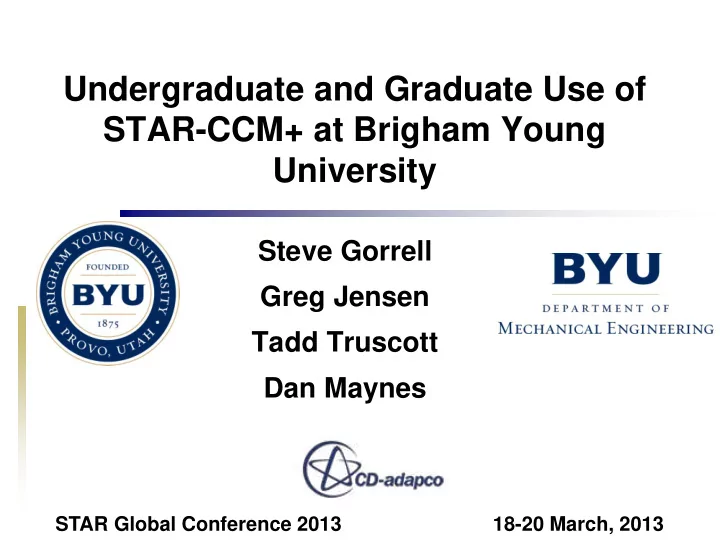

Undergraduate and Graduate Use of STAR-CCM+ at Brigham Young University Steve Gorrell Greg Jensen Tadd Truscott Dan Maynes STAR Global Conference 2013 18-20 March, 2013
Outline Introduction Coursework – Applications of Fluid Dynamics – Computer-Aided Engineering Applications Capstone – Minimizing drag on locomotive Graduate Research – Cavitation in water turbopump inducer Summary 2
Introduction CFD is a useful tool that can help students learn – Not just fluid mechanics STAR- CCM+ has features that help students quickly learn and use CFD – CAD to mesh to solution The risk – The code gave a solution therefore it is correct – Not understanding why a solution does not converge Students can do amazing things – Undergraduate as well as graduate Warning! Unedited comments included – Useful to see and appreciate students perspective – Comments do not represent opinion of Faculty or BYU
Applications of Fluid Dynamics Class has 3 overarching themes to solving fluid problems – Analytical solutions – Numerical solutions – Experimental solutions One example sphere in a cross flow – Use STAR-CCM+ to visualize and predict drag coefficients and pressure distributions. Student comments: 4 “I appreciated the time we took to learn about CFD, potential flow, and experimental fluid dynamics”
Computer-Aided Engineering Applications Over course of semester use suite of CAx and communication tools to model, analyze, and rapid prototype parts of an RC vehicle Demonstrate the appropriate application of 3D CFD to ensure appropriate air flow over the surface of your vehicle 5
Computer-Aided Engineering Applications A senior with no CFD or STAR-CCM+ experience wrote tutorials to help students on CFD portion of project – Preprocessing and Solving based on James Clement’s Surface Wrapping a Motorcycle video – Postprocessing based on James Clement’s Understanding Scenes video 6
CFD Industries & Introduction Investments Workforce Strategy Demographics Aging Population Modeling US Citizens in Israel Optimization Inflation FEA GDP & Wealth Distribution PPP& Exchange Mass Rates Motion Sim CFD Visualization
Computer-Aided Engineering Applications Student Comments about CFD – Much simpler than we thought it would be, except for meshing – Easy way to make awesome images and videos – Makes fluids seem interesting again… barely
Capstone Design of Aerodynamic Railroad Trains Objectives – Design of an aerodynamic freight locomotive – Minimize drag coefficient Student comment 9 “Vector fields allowed for visual confirmation”
Capstone Tools Used in STAR-CCM+ – Meshing – Drag analysis – Vector fields Student comments: “Varying mesh sizes saved computational time” “Allowed for amazing pictures during presentations” 10
Capstone Common reasons for failed simulations – Floating point errors – Meshing issues Optimate plug-in was unusable due to lack of instructional material or support Student comments: “Errors during meshing wasted valuable time” Successes – Able to run iterations on various models – Predict the optimal value through our optimization script 11
Water Turbopump Inducer Research Cavitation – Local static pressure drops below the vapor pressure – Fluid begins to boil and vapor bubbles Centrifugal Pump Portion form. – Unsteady two phase flow Inducer Time-accurate simulations an enabling technology Image taken from July 2004 Newsletter , Lawrence Pumps Inc http://www.lawrencepumps.com/Newsletter/news_v01_i2_july.html 12
Water Turbopump Inducer Research Turbopump Inducers – Designed to work under cavitating conditions Off-Design Operation – Inducers are designed for a given flow coefficient – Off-design flow coefficient explored 60% of design 13
Cavitation Comparison Off-Design On-Design 𝜏 ≈ 0.05 𝜏 ≈ 0.02 14
Off-Design Flow Instabilities The main reason for the increase in flow instabilities is the reversed flow at the tip Reversed flow is caused by flow separation on the inducer blade On-Design Off-Design 15
Cavitation Instabilities When the inlet pressure drops to a low enough value the core drops below the vapor pressure 16
Cavitation Instabilities The cavitation core grows and collapses causing a large cavitation surge 17
Summary STAR-CCM+ a great tool for university classroom, capstone, and research use Teaching CFD to undergraduates gives them an important skill and tool – Used while a student – Desirable skill in workforce Students can do amazing things – Undergraduate as well as graduate
Acknowledgments From CD-adapco – Lisa Mesaros – Tammy de Boer – James Clement – Bill Kester – Deryl Snyder BYU Fulton Supercomputing Laboratory – 12,356 CPU cores and 30.3 TB of memory across 928 compute nodes.
Recommend
More recommend